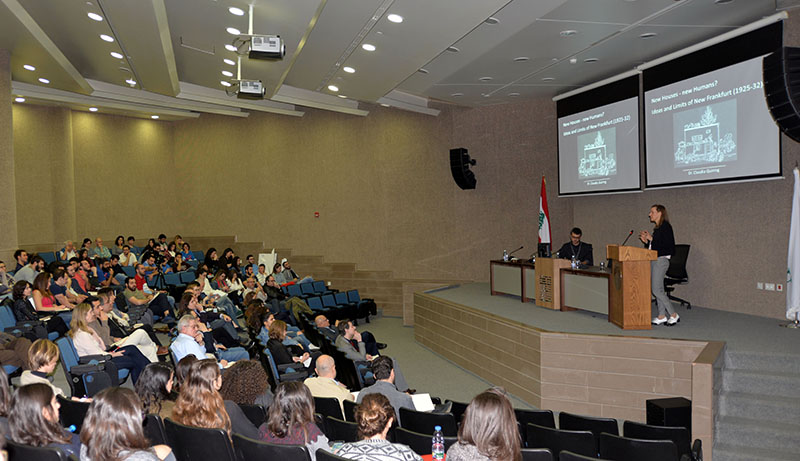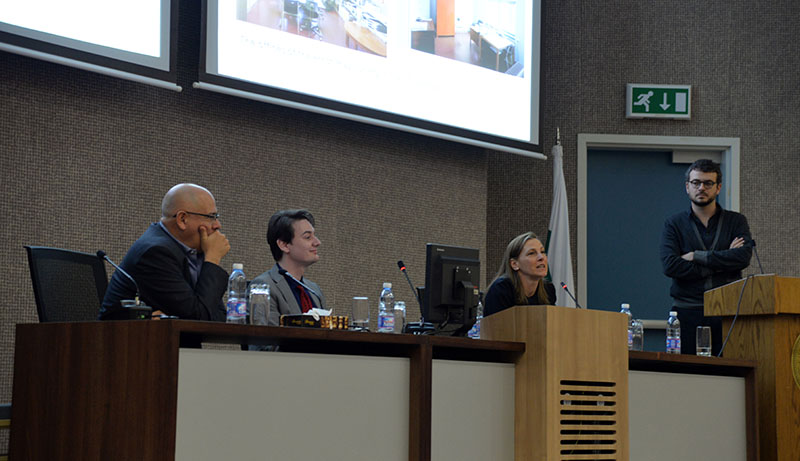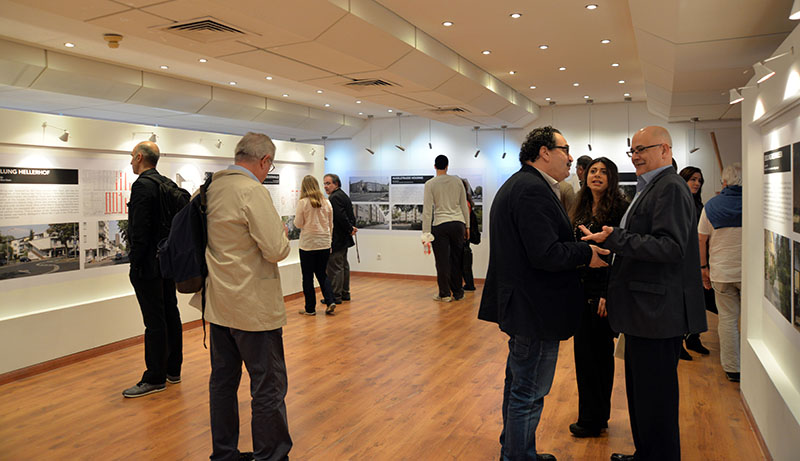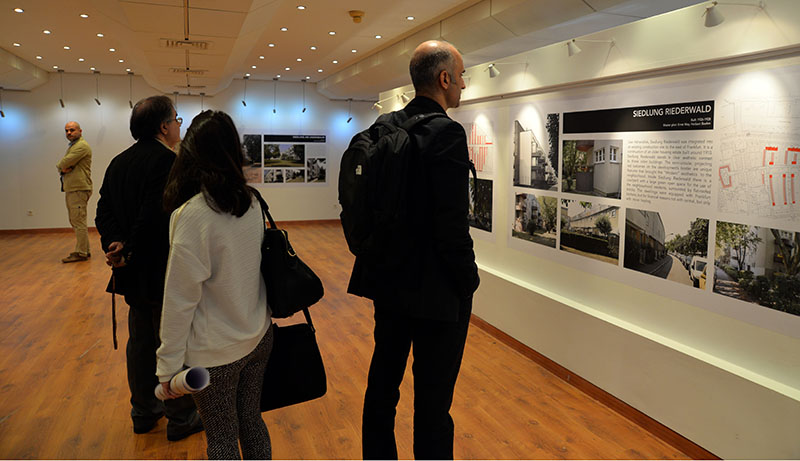Ernst May and the New Frankfurt
Economic uncertainty, a dramatically shifting political landscape and a beleaguered population - this is the backdrop for the 20th century architect and urban planner Ernst May’s New Frankfurt social housing program that would reinvent the city, and with it the everyday lives of its working class population. Over five years, May and his team developed thousands of housing units distributed across a dozen new settlements, mostly in suburban areas, surrounded by greenery and supported by public infrastructure.
A symposium delving into the context, realization and legacy of Ernst May’s post-World War I social housing program was held in Byblos earlier this month at the Gilbert and Rose-Marie Chagoury Health Sciences Center Auditorium, followed by an exhibition at the Rima Hourani Hall. Two experts on Ernst May, Claudia Quiring and Julius Reinsberg joined Elie Haddad of LAU, to speak on different aspects of The New Frankfurt.
The event and exhibition was initiated by a research visit Haddad made to Germany, sponsored by the German Academic Exchange Service (DAAD) in the summer of 2015. May’s work was of particular interest to Haddad because “…it remains a viable and functioning model of social housing that many of us in other regions of the world unfortunately still lack.” His opening lecture entitled The Realisation of an Ideal highlighted the relevance of studying the New Frankfurt project for architects today.
“I wanted to demonstrate that architecture is not only about star architects and star buildings but about a lot of other issues that architects can and should deal with. This has a far more important social impact than a single landmark building.”
Quiring’s talk, New Houses – New Humans?, focused on the human element of the New Frankfurt project. As curator of History, Architecture and Art Exhibitions at the German Architecture Museum in Frankfurt she was responsible for a major exhibition on The New Frankfurt that has been shown on three continents. She is also the co-editor of an important work on Ernst May.
Her attention to the historical context for the New Frankfurt was key to understanding its impact. As she puts it, May was not just trying to change the form and function of architecture, but the lifestyles of the inhabitants. With this program Ernst May combined architecture with urban planning, design and social engagement. Launched in 1925 and completed in 1930, the project was initiated by Frankfurt’s socialist mayor Ludwig Landmann, who hired the young architect Ernst May to lead the new Municipal Planning & Building department.
Germany in 1920 was emerging from the destruction of World War I and experimenting for the first time with democracy. Its economy in shambles from paying war reparations, inflation was so extreme that German Marks were more useful as kindling than currency. “It was nearly impossible to build houses for poor people at that time,” said Quiring, showing pictures of the tiny, cluttered apartments with no electricity or running water that housed whole families. Ernst May along with the mayor Landmann and other key players in the city municipal government saw an opportunity and a duty to offer something different for “The New Man” of “The New Frankfurt.” “They had big dreams and big obstacles,” she said.
The key elements that May and his colleagues wanted to bring to the residents of the new settlements were light, greenery and outdoor space, privacy, hygiene and a sense of community. The design tools they used to encourage this new lifestyle were jarring for some, according to Quiring. Separating the kitchen from the primary living space, giving older children their own rooms, using electricity instead of fire for heating and cooking etc. were changes reflective of a rapid shift in the dynamics within the home. The famous Frankfurt Kitchen designed by Margarete Schütte-Lihotzky and considered the forerunner for the modern fitted kitchen, was simultaneously emancipatory, more hygienic and unfamiliar to the first families who used them. It seemed, as Quiring put it, despite the architectural intentions, “They were not the new humans they should have been.”
Despite this, the overall benefits of May’s designs cannot be ignored. He and his colleagues succeeded in providing affordable, functional housing that recognized the benefits of light, easy access to green space and community services. This is a challenge that continues to face cities all over the world today.
This idea that we can find solutions to contemporary problems through investigating the work of the past was a key point of Reinsberg’s lecture on The New Frankfurt’s Heritage Site realized by the Ernst May Foundation of which Reinsberg is vice-chair. The heritage site, called the Musterhaus, is a careful restoration of an original home in one of the New Frankfurt settlements. From the 1940s the settlements had fallen into disrepair and disuse. It wasn’t until the 1980s, as Frankfurt became a financial center and there was a resurgence of interest in German architectural traditions, did the Foundation find funding and support to restore the Musterhaus and create a living example of May’s designs.
Today the settlements are still very much lived in but are now private properties and have been “individualized” by contemporary inhabitants. As Reinsberg highlighted, “Instead of the concept of community other factors like privacy or competition between the neighbors became important for the residents.” And although residents complain the walls are thin, the rooms are small and they are not well insulated, there is a sense of appreciation and novelty to living in a piece of Frankfurt’s architectural history. Their preservation and transformation act as a reminder as well of how much has changed, and those issues that still linger.
For Haddad, it is important that students at the LAU have opportunities to explore the historical and potential impacts of architecture in Lebanon and beyond. “We are encouraging more studios to deal with community projects to broaden students’ awareness of social and political issues,” he said, “so some studios are focused on team work, community and municipal projects that incorporate planning, zoning and design, not just architecture.” It is therefore important to highlight such pioneering experiments, like The New Frankfurt, which expressed a collective will to reform and improve the lives of the people.
Quiring agrees saying, as we stood in front of a photograph of one of the 1920s settlements displayed in the Rima Amal Hourani exhibition room, “It’s important to continue to tell the story of the New Frankfurt because many of the issues Ernst May was dealing with then are still unresolved today.”
This kind of symposium and exhibition is one way for LAU students to expand and deepen their study. Said one 4th year architecture student who attended the event, “The key thing I took away was how they thought then and how architects now study the past so they can apply learning to new social housing projects.”
Reinsberg confirmed the need to preserve Ernst May’s legacy and to share it around the world saying, “The New Frankfurt was a social idea, therefore it is an international idea.”



